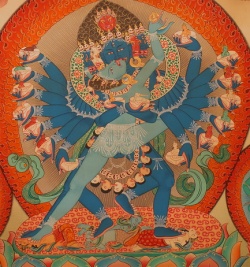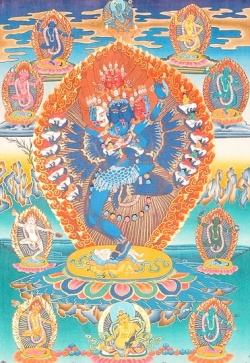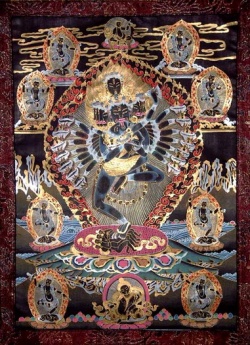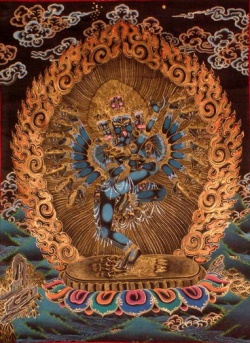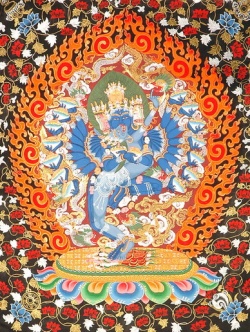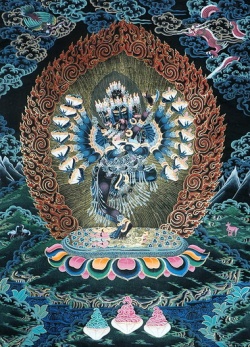Difference between revisions of "Hevajra Tantra"
| Line 1: | Line 1: | ||
[[File:Hevajra-CN5.jpg|thumb|250px|]][[File:Hevajr4.jpg|thumb|250px|]][[File:Hevajrah99.jpg|thumb|250px|]][[File:Hevajra81.jpg|thumb|250px|]][[File:Hevajra78.jpg|thumb|250px|]] | [[File:Hevajra-CN5.jpg|thumb|250px|]][[File:Hevajr4.jpg|thumb|250px|]][[File:Hevajrah99.jpg|thumb|250px|]][[File:Hevajra81.jpg|thumb|250px|]][[File:Hevajra78.jpg|thumb|250px|]] | ||
| − | + | [[File:Hevajra0445.jpg|thumb|250px|]] | |
| − | + | A [[Buddhist Tantra]] of twenty chapters, [[thought]] to have originated in the eighth century. The [[name]] is based on the {{Wiki|male}} [[deity]] [[Hevajra]], a personified [[symbol]] for the [[Buddhist]] {{Wiki|concept}} of a [[supreme being]] in the [[state]] of [[nonduality]], and as such he is most often depicted or [[visualized]] in union (Tib., [[yab-yum]]) with the [[goddess]] [[Nairatmya]]. | |
The [[Hevajra Tantra]] teaches the Union of [[Skillful Means]] and Profound [[Cognition]]; and states that such union is helpful in achieving the [[powers]] known as [[siddhis]]. The text belongs to the higher or [[Inner Tantras]] and includes the truly famous quote (the one below) that explains a basic [[tenet]] of [[Tantra]] in only a few words; as do the two others: | The [[Hevajra Tantra]] teaches the Union of [[Skillful Means]] and Profound [[Cognition]]; and states that such union is helpful in achieving the [[powers]] known as [[siddhis]]. The text belongs to the higher or [[Inner Tantras]] and includes the truly famous quote (the one below) that explains a basic [[tenet]] of [[Tantra]] in only a few words; as do the two others: | ||
| Line 23: | Line 23: | ||
The text also contains one of the most early lists naming the four major [[Pithas]], [[sacred]] places of the [[goddess]]. | The text also contains one of the most early lists naming the four major [[Pithas]], [[sacred]] places of the [[goddess]]. | ||
| − | |||
| − | + | ===[[Hevajra Initiation]]=== | |
| − | |||
| − | + | [[Hevajra Initiation]]: [[Hevajra]] is a [[tantra]] belonging to the [[scriptures]] of [[Vajrayana]], named for its main [[deity]]. It belongs to the [[Anuttara Yoga]], the [[highest]] class of [[tantra]]. [[Hevajra]] is one of the so-called Eight Great [[Heruka]] [[deities]], along with [[Hayagriva]], [[Chakrasamvara]] and [[Vajrakilaya]]. This [[Hevajra initiation]] is especially important for [[people]] who wish to [[practice]] [[Vajrayana]] seriously and for those who wish to develop a deep connection to the [[Dharma]]. | |
| + | |||
| + | The [[Hevajra initiation]] or other [[highest]] [[yoga tantra]] [[initiation]] such as [[Heruka]], [[Chakrasamvara]] or [[Kalachakra]] is required to attend teachings on the [[Six Yogas]]. | ||
| + | |||
| + | * The [[Hevajra]] [[practice]] is defined in a set of [[Hevajra]] [[root tantra]] texts ([[Tibetan]] <tt>[[kye rdo rje'i rgyud]]</tt>) from [[Kangyur]] of which there currently [[exist]] three versions: | ||
* The Extensive [[Root Tantra]] of [[Hevajra]] ([[Tibetan]] <tt>([['bum phrag bdun pa]]</tt>), consisting of seven [[hundred thousand]] verses | * The Extensive [[Root Tantra]] of [[Hevajra]] ([[Tibetan]] <tt>([['bum phrag bdun pa]]</tt>), consisting of seven [[hundred thousand]] verses | ||
| Line 38: | Line 40: | ||
== [[Books]] and Translations == | == [[Books]] and Translations == | ||
| + | |||
| + | |||
* The Concealed [[Essence]] of the [[Hevajra Tantra]], by Farrow/Menon, Motilal Banasidass Publishers, ISBN 81-208-0911-4. | * The Concealed [[Essence]] of the [[Hevajra Tantra]], by Farrow/Menon, Motilal Banasidass Publishers, ISBN 81-208-0911-4. | ||
** Has a translation of the [[Hevajra tantra]], including a commentary by [[Yogaratnamala]]. | ** Has a translation of the [[Hevajra tantra]], including a commentary by [[Yogaratnamala]]. | ||
| Line 47: | Line 51: | ||
Other sources, such as the ''[[sadhana]]'' ([[sgrub thabs]]) of the ''[[Queen of Great Bliss]]'' ([[yum bka' bde chen rgyal mo]]) from the ''[[Longchen Nyingthig]]'' (see [[Tulku Thondup]], 1985), give a different {{Wiki|enumeration}} of these [[twenty-four sacred places]]. They abide on the [[vajra-body]] [[inherent]] in every [[sentient being]], which is [[symbolized]] here by the [[body]] of [[Vajrayogini]]. These twenty-four are divided in [[three groups]]: | Other sources, such as the ''[[sadhana]]'' ([[sgrub thabs]]) of the ''[[Queen of Great Bliss]]'' ([[yum bka' bde chen rgyal mo]]) from the ''[[Longchen Nyingthig]]'' (see [[Tulku Thondup]], 1985), give a different {{Wiki|enumeration}} of these [[twenty-four sacred places]]. They abide on the [[vajra-body]] [[inherent]] in every [[sentient being]], which is [[symbolized]] here by the [[body]] of [[Vajrayogini]]. These twenty-four are divided in [[three groups]]: | ||
| − | + | ===[[Eight celestial abodes]]=== (Skt. - ''[[khagacharya]]'', Tib. - [[mkha' spyod]]) | |
| − | + | : 1) The {{Wiki|crown}} of the head is [[Jalandhara]], | |
| − | + | : 2) in between the eyebrows is [[Pulliramalaya]], | |
| − | + | : 3) the nape is [[Arbuta]], | |
| − | + | : 4) the ''[[urna]]'' (the [[hair]] at the center of the {{Wiki|forehead}}) is [[Rameshvara]], | |
| − | + | : 5) the right {{Wiki|ear}} is [[Oddiyana]], | |
| − | + | : 6) the left {{Wiki|ear}} is [[Godavari]], | |
| − | + | : 7) the [[eyes]] are [[Devikota]], and | |
| − | + | : 8) the shoulders are [[Malava]]. | |
| − | |||
| − | |||
| − | |||
| − | |||
| − | |||
| − | |||
| − | |||
| − | |||
| − | |||
| − | + | ===[[Eight earthly abodes]] (Skt. - ''[[gocharya]]'', Tib. - ''[[sa spyod]]''=== | |
| − | + | ||
| − | + | ||
| − | + | : 9) the {{Wiki|throat}} is [[Lampaka]], | |
| − | + | : 10) the underarms and {{Wiki|kidneys}} are [[Kamarupa]], | |
| − | + | : 11) the two breasts are [[Odra]], | |
| − | + | : 12) the [[navel]] is [[Trishanku]], | |
| − | + | : 13) the nose-tip is [[Koshala]], | |
| − | + | : 14) the palate is [[Kalinga]], | |
| + | : 15) the [[heart]] is both [[Kanchika]] and | ||
| + | : 16) [[Himalaya]] ([[Himavat]]). | ||
| + | |||
| + | |||
| + | |||
| + | ===[[Eight undergound abodes]] (Skt. - ''[[bhugarbha]]'', Tib. - ''[[sa 'og gi gnas brgyad]]'')=== | ||
| + | |||
| + | |||
| + | |||
| + | : 17) the genitals are [[Pretapuri]], | ||
| + | : 18) the anus is [[Grihadeva]], | ||
| + | : 19) the thumbs and the big toes are [[Maru]], | ||
| + | : 20) the thighs are [[Saurashtra]], | ||
| + | : 21) the calves are [[Suvarnadvipa]], | ||
| + | : 22) the sixteen other fingers and toes are [[Nagara]], | ||
| + | : 23) the knees are [[Kulata]], and | ||
| + | : 24) the ankles are [[Sindhu]]. | ||
The following is from [[Matthieu Ricard]] ([[MR]]) in his [[The Life of Shabkar]]. The terms you may have been searching for will appear bolded in this wonderfully educational, and highly abbreviated geographic description of ''how'' the land of [[Tibet]] actually [[lives]] through it's {{Wiki|cultural}} habitat, both historically ''and'' [[spiritually]]: | The following is from [[Matthieu Ricard]] ([[MR]]) in his [[The Life of Shabkar]]. The terms you may have been searching for will appear bolded in this wonderfully educational, and highly abbreviated geographic description of ''how'' the land of [[Tibet]] actually [[lives]] through it's {{Wiki|cultural}} habitat, both historically ''and'' [[spiritually]]: | ||
| Line 108: | Line 120: | ||
At [[Kailash]] these were under the [[leadership]] of the great ''[[pandita]]'' [[Yakgangpa]] ([[pan chen yag sgang pa]]), who is also called (according to MK, pg. 59), [[Dorzin Guhya Gangpa]] ([[rdor 'dzin guh ya sgang pa]]); at [[Lapchi]] the practitioners were led by [[Geshe Paldrak]] ([[dge bshes dpal grags]], 12th-13th century); and at [[Tsari]] they were under the guidance of [[Dorzin Gowoche]] ([[rdor 'dzin mgo bo che]]). In the [[Three Sacred Places]] of [[Tsari, Lapchi, and Kailash]], ''Dorzin'' ([[rdor 'dzin]] = ''Holder of the [[Vajra]]'') usually refers to a [[spiritual master]] or an administrator sent from [[Drigung Monastery]] as representative of the [[Drigung]] hierarchs. (see Petech 1978, 317.) ([[MR-ShabkarNotes]]). | At [[Kailash]] these were under the [[leadership]] of the great ''[[pandita]]'' [[Yakgangpa]] ([[pan chen yag sgang pa]]), who is also called (according to MK, pg. 59), [[Dorzin Guhya Gangpa]] ([[rdor 'dzin guh ya sgang pa]]); at [[Lapchi]] the practitioners were led by [[Geshe Paldrak]] ([[dge bshes dpal grags]], 12th-13th century); and at [[Tsari]] they were under the guidance of [[Dorzin Gowoche]] ([[rdor 'dzin mgo bo che]]). In the [[Three Sacred Places]] of [[Tsari, Lapchi, and Kailash]], ''Dorzin'' ([[rdor 'dzin]] = ''Holder of the [[Vajra]]'') usually refers to a [[spiritual master]] or an administrator sent from [[Drigung Monastery]] as representative of the [[Drigung]] hierarchs. (see Petech 1978, 317.) ([[MR-ShabkarNotes]]). | ||
| − | + | ||
{{R}} | {{R}} | ||
[http://rywiki.tsadra.org/index.php/Hevajra_Tantra rywiki.tsadra.org] | [http://rywiki.tsadra.org/index.php/Hevajra_Tantra rywiki.tsadra.org] | ||
[[Category:Hevajra Tantra]] | [[Category:Hevajra Tantra]] | ||
[[Category:Hevajra]] | [[Category:Hevajra]] | ||
Revision as of 15:25, 11 March 2015
A Buddhist Tantra of twenty chapters, thought to have originated in the eighth century. The name is based on the male deity Hevajra, a personified symbol for the Buddhist concept of a supreme being in the state of nonduality, and as such he is most often depicted or visualized in union (Tib., yab-yum) with the goddess Nairatmya.
The Hevajra Tantra teaches the Union of Skillful Means and Profound Cognition; and states that such union is helpful in achieving the powers known as siddhis. The text belongs to the higher or Inner Tantras and includes the truly famous quote (the one below) that explains a basic tenet of Tantra in only a few words; as do the two others:
"One must rise by that by which one falls"
"By whatever thing the world is bound, by that the bond is unfastened"
"Beings are bound by passion and are released by utilizing passion"
The Tantric reverence towards, and dependance on, women in general (and the yoni in particular), is born out in the following three quotes from the text; as is the clearly intimate nature of most higher and secret rituals:
"At all times, whether washing one’s feet or eating, rinsing the mouth, rubbing the hands, girding the hips with a loincloth, going out, making conversation, walking, standing, in wrath, in laughter; the wise man should always worship and honor the lady."
"Concentrate on the triangle of origination in the midst of space."
"I dwell in the yoni of the female in the form of semen."
The Hevajra Tantra is especially important in the Sakya-pa tradition and served as a blueprint for Virupa's Lamdre text known as Vajragatha.
The text also contains one of the most early lists naming the four major Pithas, sacred places of the goddess.
Hevajra Initiation
Hevajra Initiation: Hevajra is a tantra belonging to the scriptures of Vajrayana, named for its main deity. It belongs to the Anuttara Yoga, the highest class of tantra. Hevajra is one of the so-called Eight Great Heruka deities, along with Hayagriva, Chakrasamvara and Vajrakilaya. This Hevajra initiation is especially important for people who wish to practice Vajrayana seriously and for those who wish to develop a deep connection to the Dharma.
The Hevajra initiation or other highest yoga tantra initiation such as Heruka, Chakrasamvara or Kalachakra is required to attend teachings on the Six Yogas.
- The Hevajra practice is defined in a set of Hevajra root tantra texts (Tibetan kye rdo rje'i rgyud) from Kangyur of which there currently exist three versions:
- The Extensive Root Tantra of Hevajra (Tibetan ('bum phrag bdun pa), consisting of seven hundred thousand verses
- The Medium Root Tantra of Hevajra (Tibetan 'bum phrag lnga pa), consisting of five hundred thousand verses.
- The Condenced Hevajra Root Tantra (Tibetan brtags pa gnyis pa), also called The Two Segments.
Books and Translations
- The Concealed Essence of the Hevajra Tantra, by Farrow/Menon, Motilal Banasidass Publishers, ISBN 81-208-0911-4.
- Has a translation of the Hevajra tantra, including a commentary by Yogaratnamala.
According to the Hevajra Tantra (see Snellgrove 1959, 1:70) these are: Jalandhara, Oddiyana, Paurnagiri, Kamarupa, Malaya, Sindhu, Nagara, Munmuni, Karunyapataka, Kulata, Arbuta, Godavari, Himadri, Harikela, Lampaka, Kani, Saurasta, Kalinga, Kokana, Caritra, Kosala, and Vindhyakaumarapaurika.
Other sources, such as the sadhana (sgrub thabs) of the Queen of Great Bliss (yum bka' bde chen rgyal mo) from the Longchen Nyingthig (see Tulku Thondup, 1985), give a different enumeration of these twenty-four sacred places. They abide on the vajra-body inherent in every sentient being, which is symbolized here by the body of Vajrayogini. These twenty-four are divided in three groups:
===Eight celestial abodes=== (Skt. - khagacharya, Tib. - mkha' spyod)
- 1) The crown of the head is Jalandhara,
- 2) in between the eyebrows is Pulliramalaya,
- 3) the nape is Arbuta,
- 4) the urna (the hair at the center of the forehead) is Rameshvara,
- 5) the right ear is Oddiyana,
- 6) the left ear is Godavari,
- 7) the eyes are Devikota, and
- 8) the shoulders are Malava.
Eight earthly abodes (Skt. - gocharya, Tib. - sa spyod
- 9) the throat is Lampaka,
- 10) the underarms and kidneys are Kamarupa,
- 11) the two breasts are Odra,
- 12) the navel is Trishanku,
- 13) the nose-tip is Koshala,
- 14) the palate is Kalinga,
- 15) the heart is both Kanchika and
- 16) Himalaya (Himavat).
Eight undergound abodes (Skt. - bhugarbha, Tib. - sa 'og gi gnas brgyad)
- 17) the genitals are Pretapuri,
- 18) the anus is Grihadeva,
- 19) the thumbs and the big toes are Maru,
- 20) the thighs are Saurashtra,
- 21) the calves are Suvarnadvipa,
- 22) the sixteen other fingers and toes are Nagara,
- 23) the knees are Kulata, and
- 24) the ankles are Sindhu.
The following is from Matthieu Ricard (MR) in his The Life of Shabkar. The terms you may have been searching for will appear bolded in this wonderfully educational, and highly abbreviated geographic description of how the land of Tibet actually lives through it's cultural habitat, both historically and spiritually:
from chapter 11, pp. 342-343, note 10:
The White Snow Mountain, Kangkar Tise (gangs dkar ti se), Mt. Kailash (literally 'Silver Mountain'), is one of the world's great holy mountains, sacred to Hindus and Buddhists alike. It is one of the so-called "Three Holy Places of Tibet", associated with the body, speech, and mind aspects of Chakrasamvara and Vajravarahi. The other two are Lapchi (la phyi) and Tsari (tsa ri).
These three are also listed among the "Twenty-four Great Sacred Places" (Tib. - gnas chen nyer gzhi), (Skt. - pitha) of the world, Mt. Kailash being identified as Himavat, Lapchi as Godavari, and Tsari as both Caritra and Devikota. There are several descriptions of and guides to Mt. Kailash, including one written by Konchog Tendzin Chokyi Lodro, the sixth Drigung Chungtsang ('bri gung chung tshang dkon mchog bstan 'dzin chos kyi blo gros, 1829-1906), and a recent one composed by Choying Dorje (1990), hereafter quoted as MK.
It is recounted in the Chakrasamvara Tantra and it's commentaries (as related in MK) that the world was once ruled by Bhairava, the wrathful form of Mahadeva, who made the land of Magadha the seat of his power. It is said also that four devas and four gandharvas descended from the sky and established their dominion in the eight places known as the Eight Celestial Abodes (mkha' spyod kyi gnas brgyad).
Likewise, four yakshas and four rakshasas, already on the earthe their way to Jambudvipa, where they established themselves in the Eight Earthly Abodes (sa spyod kyi gnas brgyad, while four [[naga]s and four asuras came to Jambudvipa from beneath the eartho settle themselves in Eight Underground Abodes (sa 'og gi gnas brgyad). They invited Bhairava to visit their dwellings, twenty-four in all, but he, instead of coming personally, manifested in each place as a lingam to which these savage beings would make blood sacrifices.
These demonic forces prevailed from the "golden age" until the beginning of our present "era of strife and conflict." It was then, the tantra recounts, that the Blessed One, Vajradhara, knew that the time had come to subdue these unsuitable beings. Without his mind ever wavering from objectless compassion (dmigs pa med pa'i snying rje), he arose in the formidable wrathful display of a Heruka with four heads and twelve arms. He danced, and through the power of the nondual wisdom of all the Buddhas, trampled down Mahadeva and his consort together with their retinue, liberating their minds into the absolute expanse and establishing them in great bliss.
The Heruka then blessed each of the twenty-four abodes as a palace of Chakrasamvara and each of the twenty-four lingams as a mandala of sixty-two wisdom deities. The sixty-two are Chakrasamvara and his consort, and his retinue: the twenty-four male and twenty-four female Bodhisattvas, and the twelve goddesses.
At the nirmanakaya level, it is said that Mt. Kailash was miraculously blessed by Buddha Shakyamuni and five hundred arhats. Once, Ravana (mgon po beng) and his consort had taken to their palace in Lanka one of the three statues of Buddha Shakyamuni which the Lord himself had blessed. Desiring to place this statue on a worthy support, Ravana had planned to take Mt. Kailash on his back and carry it to Lanka. At the same moment Lord Buddha and five hundred arhats came flying through the sky and alighted to the west of Mt. Kailash, leaving their footprints in the rock.
The Buddha stepped on all four sides of the mountain, leaving footprints in the rock which are known as the Four Immutable Nails of Kailash (mi 'gyur ba'i gzer bzhi). Ravana thus was unable to lift the mountain. Then the Buddha sat on a rock in front of the mountain and taught Dharma to the naga king Anavatapta, the lord of the Lake Manasarovar. He then taught the Lankavatara Sutra to Ravana, and blessed him and his consort as the Glorious Wisdom Protector, the Great Being and Consort (dpal ye shes mgon po beng chen lcam dral).
Mt. Kailash was later blessed by Guru Padmasambhava, and became famous after Jetsun Milarepa lived there and held his contest of miracles with Naro Bonchung. (When Jetsun Milarepa and the Bonpo Naro Bonchung held their famous contest of miracles to decide who would retain supremacy over the sacred mountain, they left imprints of their feet in the rocks and many other miraculous signs.
See G. C. C. Chang, (1962, vol. 1, pp. 215-224). Later Gyalwa Gotsangpa (rgod tshang pa mgon po rdo rje), Linge Repa (gling rje ras pa) (1128-1188), and many other great meditators lived ascetic lives at the foot of Mt. Kailash.
In particular, holders of the Drigung Kagyu lineage frequented this place in great numbers. Drigung Jigten Gonpo ('bri gung 'jigs rten mgon po 1143-1217) had a dream in which the guardian deities of the Three Sacred Places of Tsari, Lapchi, and Kailash came and prostrated themselves before him, requesting him to go and bless their territories. Jigten Gonpo replied that he would send great meditators instead. Accordingly, he dispatched 80 hermits to each place. Some years later, he reputedly sent 900 hermits and finally 55,525 practitioners to each site (see Huber, 1989).
At Kailash these were under the leadership of the great pandita Yakgangpa (pan chen yag sgang pa), who is also called (according to MK, pg. 59), Dorzin Guhya Gangpa (rdor 'dzin guh ya sgang pa); at Lapchi the practitioners were led by Geshe Paldrak (dge bshes dpal grags, 12th-13th century); and at Tsari they were under the guidance of Dorzin Gowoche (rdor 'dzin mgo bo che). In the Three Sacred Places of Tsari, Lapchi, and Kailash, Dorzin (rdor 'dzin = Holder of the Vajra) usually refers to a spiritual master or an administrator sent from Drigung Monastery as representative of the Drigung hierarchs. (see Petech 1978, 317.) (MR-ShabkarNotes).
